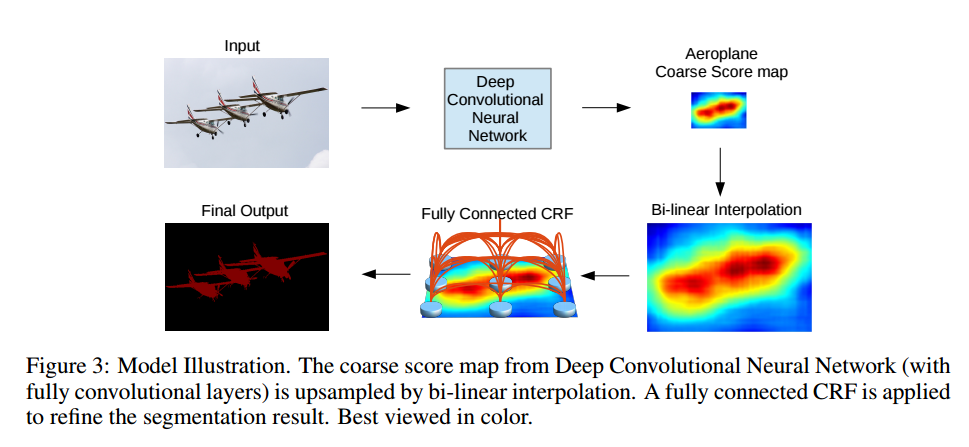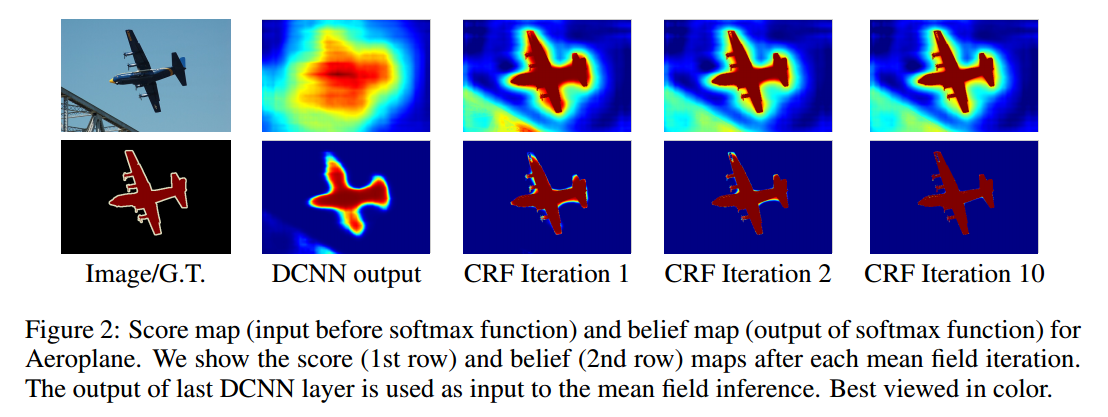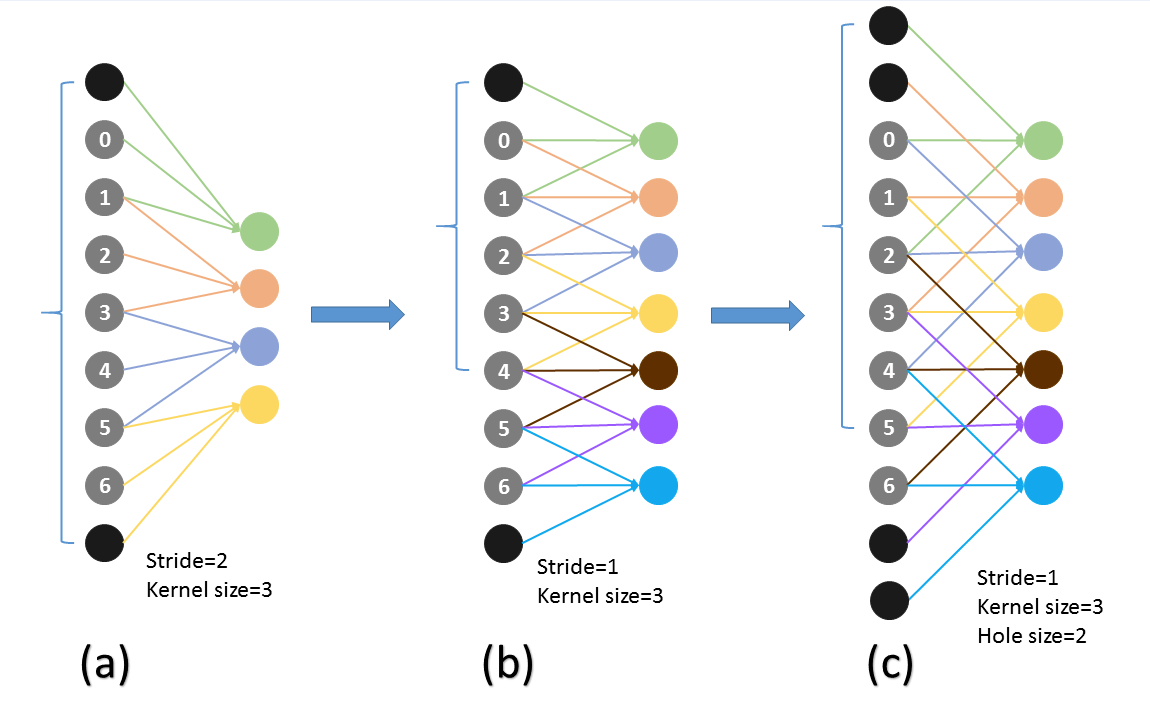尊重原创,转载请注明:http://blog.csdn.net/tangwei2014
deeplab 发表在ICLR 2015上。论文下载地址:Semantic Image Segmentation with Deep Convolutional Nets and Fully Connected CRFS .
deeplab 方法概述 FCN 得到 coarse score map并插值到原图像大小,然后第二步借用fully connected CRF对从FCN得到的分割结果进行细节上的refine。(有关FCN 的内容介绍,可以参考我的前面得一篇博客:http://blog.csdn.net/tangwei2014/article/details/46882257 )
deeplab对FCN 更加优雅的处理方式 deeplab 仍然采用了FCN 来得到score map,并且也是在VGG网络上进行fine-tuning。但是在得到score map的处理方式上,要比原FCN处理的优雅很多。 FCN 中是怎么得到一个更加dense的score map的吗? 是一张500x500的输入图像,直接在第一个卷积层上conv1_1来了一个100的大padding。最终在fc7层勉强得到一个16x16的score map。虽然处理上稍显粗糙,但是毕竟人家是第一次将图像分割在CNN上搞成end-to-end,并且在当时performance是state-of-the-art,也很理解。 deeplab 摒弃了这种做法,取而代之的是对VGG的网络结构上做了小改动:将VGG网络的pool4 和pool5 层的stride由原来的2改为了1。就是这样一个改动,使得vgg网络总的stride由原来的32变成8,进而使得在输入图像为514x514,正常的padding时,fc7能得到67x67的score map, 要比FCN 确实要dense很多很多。
Hole算法 既想利用已经训练好的模型进行fine-tuning,又想改变网络结构得到更加dense的score map.
代码
主要是im2col(前传)和col2im(反传)中做了改动 (增加了hole_w, hole_h),这里只贴cpu的用于理解:
template <typename Dtype>
void im2col_cpu(const Dtype* data_im,
const int num, const int channels, const int height, const int width,
const int kernel_h, const int kernel_w, const int pad_h, const int pad_w,
const int stride_h, const int stride_w, const int hole_h, const int hole_w,
Dtype* data_col) {
const int kernel_h_eff = kernel_h + (kernel_h - 1 ) * (hole_h - 1 );
const int kernel_w_eff = kernel_w + (kernel_w - 1 ) * (hole_w - 1 );
int height_col = (height + 2 * pad_h - kernel_h_eff) / stride_h + 1 ;
int width_col = (width + 2 * pad_w - kernel_w_eff) / stride_w + 1 ;
int channels_col = channels * kernel_h * kernel_w;
for (int n = 0 ; n < num; ++n) {
for (int c = 0 ; c < channels_col; ++c) {
int w_offset = (c % kernel_w) * hole_w;
int h_offset = ((c / kernel_w) % kernel_h) * hole_h;
int c_im = c / kernel_w / kernel_h;
for (int h = 0 ; h < height_col; ++h) {
const int h_im = h * stride_h + h_offset - pad_h;
for (int w = 0 ; w < width_col; ++w) {
const int w_im = w * stride_w + w_offset - pad_w;
data_col[((n * channels_col + c) * height_col + h) * width_col + w] =
(h_im >= 0 && h_im < height && w_im >= 0 && w_im < width) ?
data_im[((n * channels + c_im) * height + h_im) * width + w_im] :
0. ;
}
}
}
}
}
template <typename Dtype>
void col2im_cpu(const Dtype* data_col,
const int num, const int channels, const int height, const int width,
const int kernel_h, const int kernel_w, const int pad_h, const int pad_w,
const int stride_h, const int stride_w, const int hole_h, const int hole_w,
Dtype* data_im) {
caffe_set(num * channels * height * width, Dtype(0 ), data_im);
const int kernel_h_eff = kernel_h + (kernel_h - 1 ) * (hole_h - 1 );
const int kernel_w_eff = kernel_w + (kernel_w - 1 ) * (hole_w - 1 );
int height_col = (height + 2 * pad_h - kernel_h_eff) / stride_h + 1 ;
int width_col = (width + 2 * pad_w - kernel_w_eff) / stride_w + 1 ;
int channels_col = channels * kernel_h * kernel_w;
for (int n = 0 ; n < num; ++n) {
for (int c = 0 ; c < channels_col; ++c) {
int w_offset = (c % kernel_w) * hole_w;
int h_offset = ((c / kernel_w) % kernel_h) * hole_h;
int c_im = c / kernel_w / kernel_h;
for (int h = 0 ; h < height_col; ++h) {
const int h_im = h * stride_h + h_offset - pad_h;
for (int w = 0 ; w < width_col; ++w) {
const int w_im = w * stride_w + w_offset - pad_w;
if (h_im >= 0 && h_im < height && w_im >= 0 && w_im < width) {
data_im[((n * channels + c_im) * height + h_im) * width + w_im] +=
data_col[((n * channels_col + c) * height_col + h) * width_col + w];
}
}
}
}
}
}
























 3万+
3万+











 被折叠的 条评论
为什么被折叠?
被折叠的 条评论
为什么被折叠?








